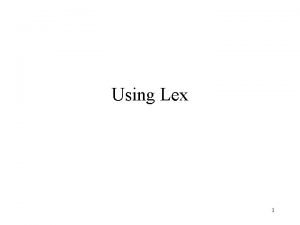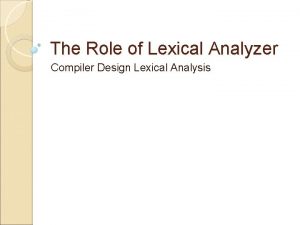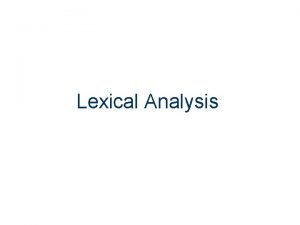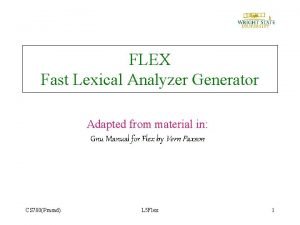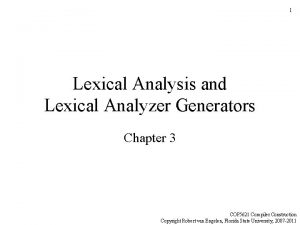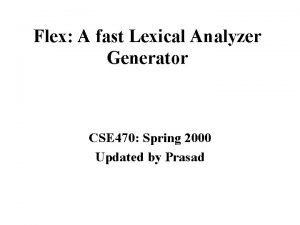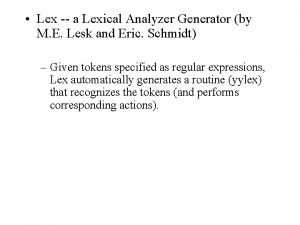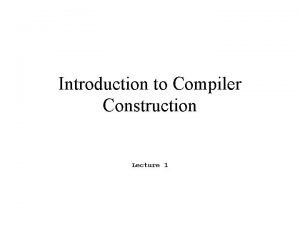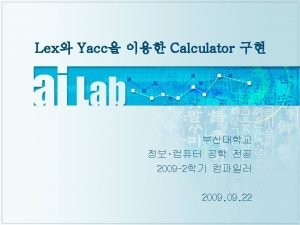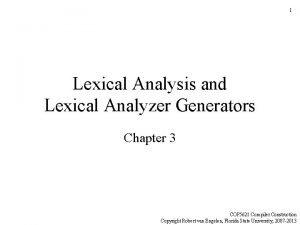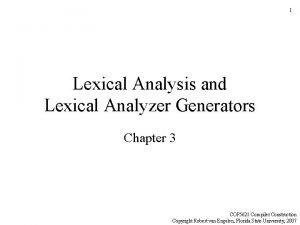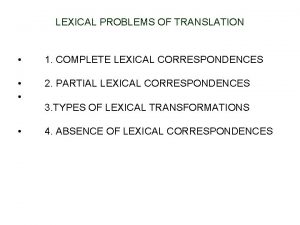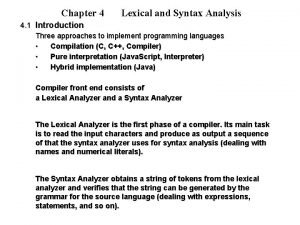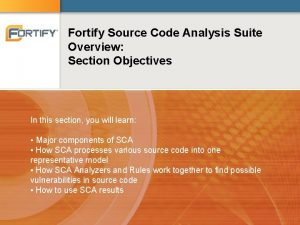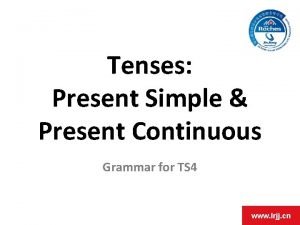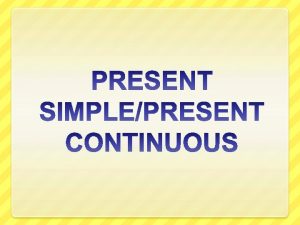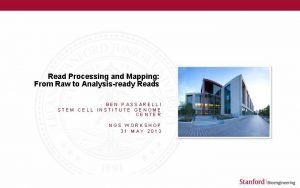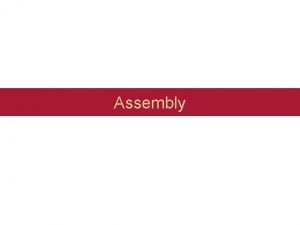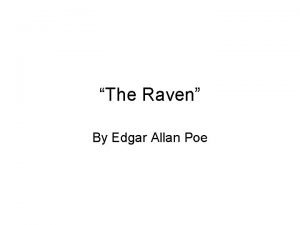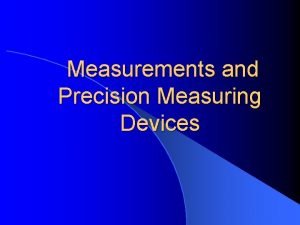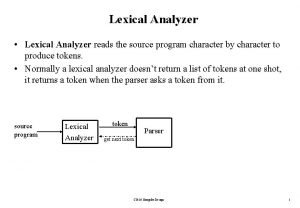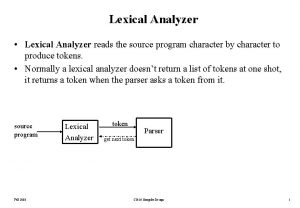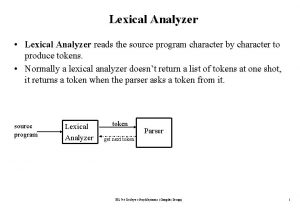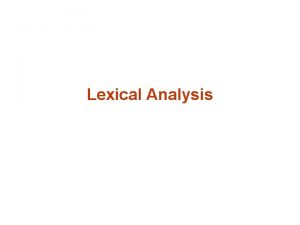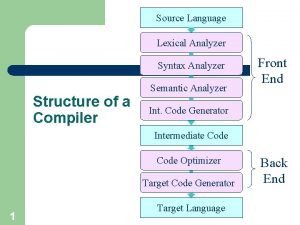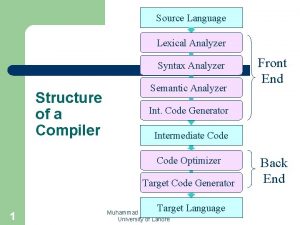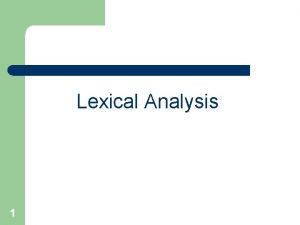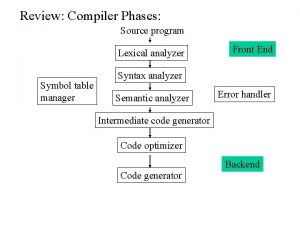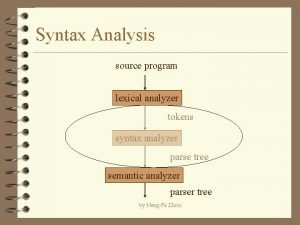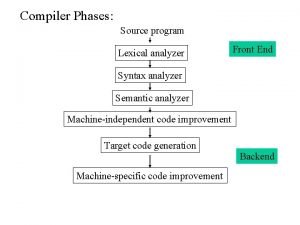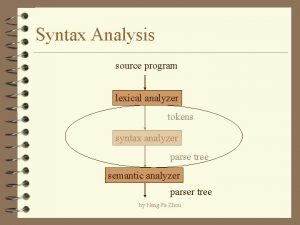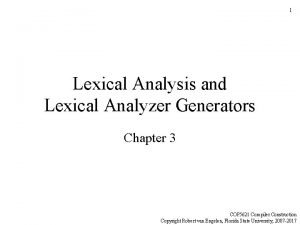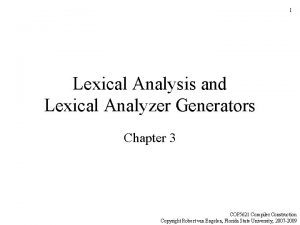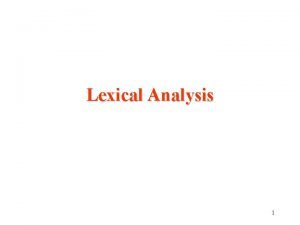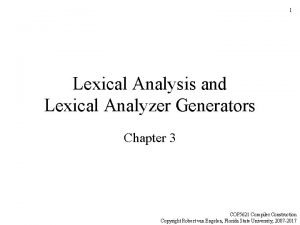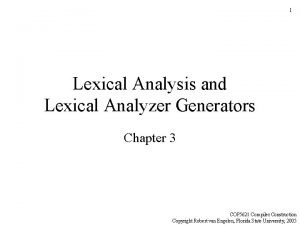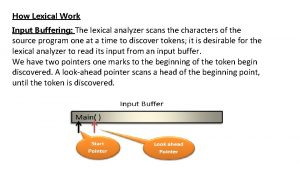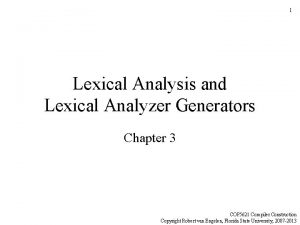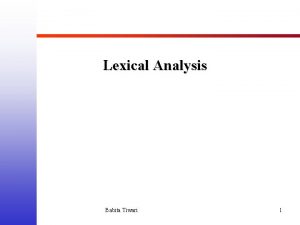Lexical Analyzer Lexical Analyzer reads the source program



























- Slides: 27

Lexical Analyzer • Lexical Analyzer reads the source program character by character to produce tokens. • Normally a lexical analyzer doesn’t return a list of tokens at one shot, it returns a token when the parser asks a token from it. source program Lexical Analyzer token Parser get next token 1

Token • Token represents a set of strings described by a pattern. – Identifier represents a set of strings which start with a letter continues with letters and digits – The actual string (newval) is called as lexeme. – Tokens: identifier, number, addop, delimeter, … • Since a token can represent more than one lexeme, additional information should be held for that specific lexeme. This additional information is called as the attribute of the token. • For simplicity, a token may have a single attribute which holds the required information for that token. – For identifiers, this attribute a pointer to the symbol table, and the symbol table holds the actual attributes for that token. • Some attributes: – <id, attr> – <assgop, _> – <num, val> where attr is pointer to the symbol table no attribute is needed (if there is only one assignment operator) where val is the actual value of the number. • Token type and its attribute uniquely identifies a lexeme. • Regular expressions are widely used to specify patterns. 2

Terminology of Languages • Alphabet : a finite set of symbols (ASCII characters) • String : – – Finite sequence of symbols on an alphabet Sentence and word are also used in terms of string is the empty string |s| is the length of string s. • Language: sets of strings over some fixed alphabet – – the empty set is a language. { } the set containing empty string is a language The set of well-formed C programs is a language The set of all possible identifiers is a language. • Operators on Strings: – Concatenation: xy represents the concatenation of strings x and y. s = s – sn = s s s. . s ( n times) s 0 = s=s 3

Operations on Languages • Concatenation: – L 1 L 2 = { s 1 s 2 | s 1 L 1 and s 2 L 2 } • Union – L 1 L 2 = { s | s L 1 or s L 2 } • Exponentiation: – L 0 = { } L 1 = L L 2 = LL • Kleene Closure – L* = • Positive Closure – L+ = 4

Example • L 1 = {a, b, c, d} L 2 = {1, 2} • L 1 L 2 = {a 1, a 2, b 1, b 2, c 1, c 2, d 1, d 2} • L 1 L 2 = {a, b, c, d, 1, 2} • L 13 = all strings with length three (using a, b, c, d} • L 1* = all strings using letters a, b, c, d and empty string • L 1+ = doesn’t include the empty string 5

Regular Expressions • We use regular expressions to describe tokens of a programming language. • A regular expression is built up of simpler regular expressions (using defining rules) • Each regular expression denotes a language. • A language denoted by a regular expression is called as a regular set. 6

Regular Expressions (Rules) Regular expressions over alphabet Reg. Expr a (r 1) | (r 2) (r 1) (r 2) (r)* (r) Language it denotes { } {a} L(r 1) L(r 2) L(r 1) L(r 2) (L(r))* L(r) • (r)+ = (r)(r)* • (r)? = (r) | 7

Regular Expressions (cont. ) • We may remove parentheses by using precedence rules. – * – concatenation – | • ab*|c means highest next lowest (a(b)*)|(c) • Ex: – – – = {0, 1} 0|1 => {0, 1} (0|1) => {00, 01, 10, 11} 0* => { , 0, 000, 0000, . . } (0|1)* => all strings with 0 and 1, including the empty string 8

Regular Definitions • To write regular expression for some languages can be difficult, because their regular expressions can be quite complex. In those cases, we may use regular definitions. • We can give names to regular expressions, and we can use these names as symbols to define other regular expressions. • A regular definition is a sequence of the definitions of the form: d 1 r 1 where di is a distinct name and d 2 r 2 ri is a regular expression over symbols in. {d 1, d 2, . . . , di-1} dn rn basic symbols previously defined names 9

Regular Definitions (cont. ) • Ex: Identifiers in Pascal letter A | B |. . . | Z | a | b |. . . | z digit 0 | 1 |. . . | 9 id letter (letter | digit ) * – If we try to write the regular expression representing identifiers without using regular definitions, that regular expression will be complex. (A|. . . |Z|a|. . . |z) ( (A|. . . |Z|a|. . . |z) | (0|. . . |9) ) * • Ex: Unsigned numbers in Pascal digit 0 | 1 |. . . | 9 digits digit + opt-fraction (. digits ) ? opt-exponent ( E (+|-)? digits ) ? unsigned-num digits opt-fraction opt-exponent 10

Finite Automata • A recognizer for a language is a program that takes a string x, and answers “yes” if x is a sentence of that language, and “no” otherwise. • We call the recognizer of the tokens as a finite automaton. • A finite automaton can be: deterministic(DFA) or non-deterministic (NFA) • This means that we may use a deterministic or non-deterministic automaton as a lexical analyzer. • Both deterministic and non-deterministic finite automaton recognize regular sets. • Which one? – deterministic – faster recognizer, but it may take more space – non-deterministic – slower, but it may take less space – Deterministic automatons are widely used lexical analyzers. • First, we define regular expressions for tokens; Then we convert them into a DFA to get a lexical analyzer for our tokens. – Algorithm 1: Regular Expression NFA DFA (two steps: first to NFA, then to DFA) – Algorithm 2: Regular Expression DFA (directly convert a regular expression into a DFA) 11

Non-Deterministic Finite Automaton (NFA) • A non-deterministic finite automaton (NFA) is a mathematical model that consists of: – – – S - a set of states - a set of input symbols (alphabet) move – a transition function move to map state-symbol pairs to sets of states. s 0 - a start (initial) state F – a set of accepting states (final states) • - transitions are allowed in NFAs. In other words, we can move from one state to another one without consuming any symbol. • A NFA accepts a string x, if and only if there is a path from the starting state to one of accepting states such that edge labels along this path spell out x. BİL 744 Derleyici Gerçekleştirimi (Compiler Design) 12

NFA (Example) a start 0 a 1 b b Transition graph of the NFA 2 0 is the start state s 0 {2} is the set of final states F = {a, b} S = {0, 1, 2} Transition Function: a 0 {0, 1} 1 _ 2 _ b {0} {2} _ The language recognized by this NFA is (a|b) * a b 13

Deterministic Finite Automaton (DFA) • A Deterministic Finite Automaton (DFA) is a special form of a NFA. • no state has - transition • for each symbol a and state s, there is at most one labeled edge a leaving s. i. e. transition function is from pair of state-symbol to state (not set of states) b 0 a a a 1 b The language recognized by 2 this DFA is also (a|b) * a b b 14

Implementing a DFA • Le us assume that the end of a string is marked with a special symbol (say eos). The algorithm for recognition will be as follows: (an efficient implementation) s s 0 c nextchar while (c != eos) do begin s move(s, c) c nextchar end if (s in F) then return “yes” else return “no” { start from the initial state } { get the next character from the input string } { do until the en dof the string } { transition function } { if s is an accepting state } 15

Implementing a NFA S -closure({s 0}) { set all of states can be accessible from s 0 by -transitions } c nextchar while (c != eos) { begin s -closure(move(S, c)) { set of all states can be accessible from a state in S c nextchar by a transition on c } end if (S F != ) then return “yes” else return “no” • { if S contains an accepting state } This algorithm is not efficient. 16

Converting A Regular Expression into A NFA (Thomson’s Construction) • This is one way to convert a regular expression into a NFA. • There can be other ways (much efficient) for the conversion. • Thomson’s Construction is simple and systematic method. It guarantees that the resulting NFA will have exactly one final state, and one start state. • Construction starts from simplest parts (alphabet symbols). To create a NFA for a complex regular expression, NFAs of its sub -expressions are combined to create its NFA, 17

Thomson’s Construction (cont. ) i • To recognize an empty string • To recognize a symbol a in the alphabet i a f f • If N(r 1) and N(r 2) are NFAs for regular expressions r 1 and r 2 • For regular expression r 1 | r 2 i N(r 1) f NFA for r 1 | r 2 N(r 2) 18

Thomson’s Construction (cont. ) • For regular expression r 1 r 2 i N(r 1) N(r 2) Final state of N(r 2) become final state of N(r 1 r 2) f NFA for r 1 r 2 • For regular expression r* i N(r) f NFA for r* 19

Thomson’s Construction (Example - (a|b) * a ) a: b: a a (a | b) b b (a|b) * a b (a|b) * a b a 20

Converting a NFA into a DFA (subset construction) put -closure({s 0}) as an unmarked state into the set of DFA (DS) while (there is one unmarked S 1 in DS) do -closure({s 0}) is the set of all states can be accessible begin from s 0 by -transition. mark S 1 set of states to which there is a transition on for each input symbol a do a from a state s in S 1 begin S 2 -closure(move(S 1, a)) if (S 2 is not in DS) then add S 2 into DS as an unmarked state transfunc[S 1, a] S 2 end • a state S in DS is an accepting state of DFA if a state in S is an accepting state of NFA • the start state of DFA is -closure({s 0}) 21

Converting a NFA into a DFA (Example) 0 1 2 a 3 4 b 6 7 a 8 5 S 0 = -closure({0}) = {0, 1, 2, 4, 7} S 0 into DS as an unmarked state mark S 0 -closure(move(S 0, a)) = -closure({3, 8}) = {1, 2, 3, 4, 6, 7, 8} = S 1 into DS -closure(move(S 0, b)) = -closure({5}) = {1, 2, 4, 5, 6, 7} = S 2 into DS transfunc[S 0, a] S 1 transfunc[S 0, b] S 2 mark S 1 -closure(move(S 1, a)) = -closure({3, 8}) = {1, 2, 3, 4, 6, 7, 8} = S 1 -closure(move(S 1, b)) = -closure({5}) = {1, 2, 4, 5, 6, 7} = S 2 transfunc[S 1, a] S 1 transfunc[S 1, b] S 2 mark S 2 -closure(move(S 2, a)) = -closure({3, 8}) = {1, 2, 3, 4, 6, 7, 8} = S 1 -closure(move(S 2, b)) = -closure({5}) = {1, 2, 4, 5, 6, 7} = S 2 transfunc[S 2, a] S 1 transfunc[S 2, b] S 2 22

Converting a NFA into a DFA (Example – cont. ) S 0 is the start state of DFA since 0 is a member of S 0={0, 1, 2, 4, 7} S 1 is an accepting state of DFA since 8 is a member of S 1 = {1, 2, 3, 4, 6, 7, 8} S 2 = {1, 2, 4, 5, 6, 7} a S 1 a S 0 b a b S 2 b 23

Transition diagrams • Transition diagram for relop

Transition diagrams (cont. ) • Transition diagram for reserved words and identifiers letter A | B |. . . | Z | a | b |. . . | z digit 0 | 1 |. . . | 9 id letter (letter | digit ) *

Transition diagrams (cont. ) • Transition diagram for unsigned numbers digit 0 | 1 |. . . | 9 digits digit + opt-fraction (. digits ) ? opt-exponent ( E (+|-)? digits ) ? unsigned-num digit + (. digits ) ? ( E (+|-)? digits ) ?

Transition diagrams (cont. ) • Transition diagram for whitespace delim +
 Flex lexical analyzer
Flex lexical analyzer The role of the lexical analyzer
The role of the lexical analyzer Lexical analysis example
Lexical analysis example Flex lexical analyzer
Flex lexical analyzer Lexical analysis generator
Lexical analysis generator Flex lexical analyzer example
Flex lexical analyzer example Lexical analyzer generator lex
Lexical analyzer generator lex If the lexical analyzer finds a token invalid then?
If the lexical analyzer finds a token invalid then? Yacc 사용법
Yacc 사용법 Lexical
Lexical Design of lexical analyzer generator
Design of lexical analyzer generator Octopoxho in english
Octopoxho in english Syntax analyzer source code in java
Syntax analyzer source code in java Transient line source method
Transient line source method Source code
Source code Simple present help
Simple present help Put in the verbs in brackets into the gaps. use will-future
Put in the verbs in brackets into the gaps. use will-future Repeated actions present simple
Repeated actions present simple Raw reads meaning
Raw reads meaning A mechanism that spins, reads, and writes disks.
A mechanism that spins, reads, and writes disks. Nebraska reads approved assessments
Nebraska reads approved assessments Bandage github
Bandage github Poems with literary devices highlighted
Poems with literary devices highlighted Modelled reading
Modelled reading The usc micrometer reads in
The usc micrometer reads in As jeff reads his psychology textbook
As jeff reads his psychology textbook Fpros
Fpros Input devices
Input devices
